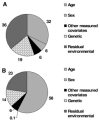Determinants of coronary artery and aortic calcification in the Old Order Amish
- PMID: 17261661
- PMCID: PMC4039563
- DOI: 10.1161/CIRCULATIONAHA.106.637512
Determinants of coronary artery and aortic calcification in the Old Order Amish
Abstract
Background: Coronary artery calcification (CAC) is associated with an increased risk of cardiovascular disease; little is known, however, about thoracic aortic calcification (AC). Our goal was to characterize risk factors for CAC and AC and to estimate the genetic contribution to their variation.
Methods and results: The presence and quantity of CAC and AC were measured with electron beam computed tomography and fasting blood tests and cardiovascular risk factors were obtained in 614 asymptomatic Amish subjects. CAC prevalence was higher in men than women (55% versus 41%; P<0.0001), although there was no sex difference in AC prevalence (51% and 56% in men and women, respectively; P=0.95). Age was more strongly associated with AC presence (odds ratio [OR], 2.7 for 5 years) than CAC presence (OR, 1.9 for 5 years) (homogeneity P=0.001). Subjects with AC had a 3.3-fold higher odds of having CAC. Heritabilities of CAC and AC presence were 0.27+/-0.17 (P=0.04) and 0.55+/-0.18 (P=0.0008), respectively, whereas the heritabilities of quantity of CAC and AC were 0.30+/-0.10 (P=0.001) and 0.40+/-0.10 (P<0.0001), respectively. The genetic correlation between CAC and AC quantity was 0.34+/-0.19, whereas the environmental correlation between these 2 traits was 0.38+/-0.09.
Conclusions: CAC and AC have similar risk factors, except male gender is associated only with CAC and age is more strongly associated with AC. The patterns of correlations suggest that CAC and AC share some common sets of genes and environmental factors, although it is likely that separate genes and environmental factors also influence calcification at each site.
Figures


Similar articles
-
Evidence for an association between metabolic cardiovascular syndrome and coronary and aortic calcification among women with polycystic ovary syndrome.J Clin Endocrinol Metab. 2004 Nov;89(11):5454-61. doi: 10.1210/jc.2003-032237. J Clin Endocrinol Metab. 2004. PMID: 15531497
-
Parental occurrence of premature cardiovascular disease predicts increased coronary artery and abdominal aortic calcification in the Framingham Offspring and Third Generation cohorts.Circulation. 2007 Sep 25;116(13):1473-81. doi: 10.1161/CIRCULATIONAHA.107.705202. Epub 2007 Sep 4. Circulation. 2007. PMID: 17785619
-
Electron beam computed tomography evidence of aortic calcification as an independent determinant of coronary artery calcification.J Chin Med Assoc. 2006 Sep;69(9):409-14. doi: 10.1016/S1726-4901(09)70283-7. J Chin Med Assoc. 2006. PMID: 17051751
-
Coronary artery calcification and family history of premature coronary heart disease: sibling history is more strongly associated than parental history.Circulation. 2004 Oct 12;110(15):2150-6. doi: 10.1161/01.CIR.0000144464.11080.14. Epub 2004 Oct 4. Circulation. 2004. PMID: 15466626
-
Extracoronary Thoracic and Coronary Artery Calcifications on Chest CT for Lung Cancer Screening: Association with Established Cardiovascular Risk Factors - The "CT-Risk" Trial.Acad Radiol. 2015 Jul;22(7):880-9. doi: 10.1016/j.acra.2015.03.005. Epub 2015 May 7. Acad Radiol. 2015. PMID: 25957500 Review.
Cited by
-
Calcified granulomatous disease: occupational associations and lack of familial aggregation.Lung. 2014 Dec;192(6):841-7. doi: 10.1007/s00408-014-9624-3. Epub 2014 Jul 20. Lung. 2014. PMID: 25038755 Free PMC article.
-
HDAC9 is implicated in atherosclerotic aortic calcification and affects vascular smooth muscle cell phenotype.Nat Genet. 2019 Nov;51(11):1580-1587. doi: 10.1038/s41588-019-0514-8. Epub 2019 Oct 28. Nat Genet. 2019. PMID: 31659325 Free PMC article.
-
Aortic stiffness and calcification in men in a population-based international study.Atherosclerosis. 2012 Jun;222(2):473-7. doi: 10.1016/j.atherosclerosis.2012.03.027. Epub 2012 Mar 27. Atherosclerosis. 2012. PMID: 22537531 Free PMC article.
-
Familial defective apolipoprotein B-100 and increased low-density lipoprotein cholesterol and coronary artery calcification in the old order amish.Arch Intern Med. 2010 Nov 8;170(20):1850-5. doi: 10.1001/archinternmed.2010.384. Arch Intern Med. 2010. PMID: 21059979 Free PMC article.
-
Familial Hypercholesterolemia and Type 2 Diabetes in the Old Order Amish.Diabetes. 2017 Jul;66(7):2054-2058. doi: 10.2337/db17-0173. Epub 2017 Apr 20. Diabetes. 2017. PMID: 28428224 Free PMC article.
References
-
- Taylor AJ, Merz CN, Udelson JE. 34th Bethesda Conference: executive summary: can atherosclerosis imaging techniques improve the detection of patients at risk for ischemic heart disease? J Am Coll Cardiol. 2003;41:1860–1862. - PubMed
-
- Rumberger JA, Simons DB, Fitzpatrick LA, Sheedy PF, Schwartz RS. Coronary artery calcium area by electron-beam computed tomography and coronary atherosclerotic plaque area: a histopathologic correlative study. Circulation. 1995;92:2157–2162. - PubMed
-
- Greenland P, LaBree L, Azen SP, Doherty TM, Detrano RC. Coronary artery calcium score combined with Framingham score for risk prediction in asymptomatic individuals. JAMA. 2004;291:210–215. - PubMed
-
- Raggi P, Callister TQ, Cooil B, He ZX, Lippolis NJ, Russo DJ, Zelinger A, Mahmarian JJ. Identification of patients at increased risk of first unheralded acute myocardial infarction by electron-beam computed tomography. Circulation. 2000;101:850–855. - PubMed
-
- Arad Y, Goodman KJ, Roth M, Newstein D, Guerci AD. Coronary calcification, coronary disease risk factors, C-reactive protein, and atherosclerotic cardiovascular disease events: the St. Francis Heart Study. J Am Coll Cardiol. 2005;46:158–165. - PubMed
Publication types
MeSH terms
Grants and funding
LinkOut - more resources
Full Text Sources

